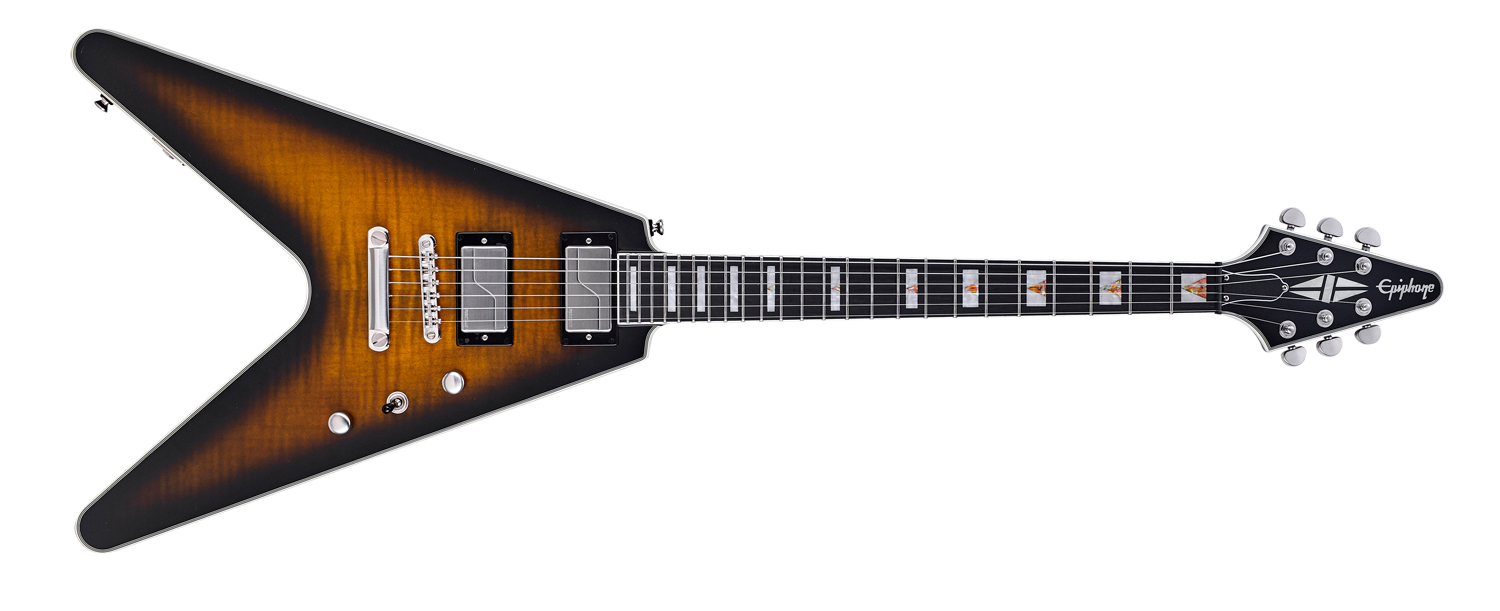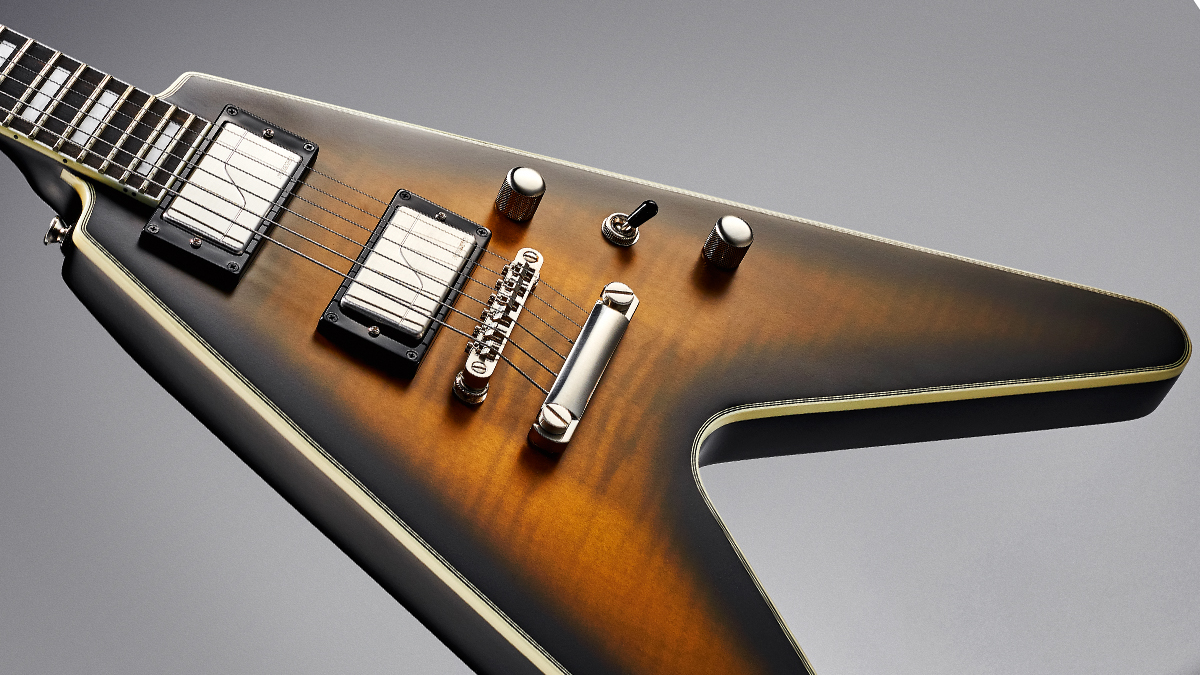MusicRadar Verdict
The Epiphone Prophecy Flying V is a high-performance electric guitar that is exceptional for metal but with enough range to make it a quite thrilling update to a classic design.
Pros
- +
The quality of spec and build is exceptional.
- +
Neck feels shreddable without being too skinny.
- +
Fluence humbuckers offer plenty of tone options.
- +
Can't argue with the price.
Cons
- -
Always the same with Vs, playing them seated can be a chore.
- -
No lefties.
MusicRadar's got your back
What is it?
The Epiphone Prophecy range of electric guitars is designed with the noble pursuit of heavy metal guitar playing in mind. Like its siblings, it takes some Gibson design DNA onboard. You'll recognise the shapes. Then it gives it the ordnance for high-gain, high-speed performance.
There are SG, Les Paul and Extura models in the range, but there is something about the Flying V profile, still modern and aggressive after all these years (crazy to think that it's a '50s design), that makes it the perfect candidate for such treatment.
This 2020 Prophecy Series Flying V has a Custom vibe about it. It has the split diamond inlay on the headstock and there is a generously thick multi-ply binding around the body and headstock, with a bound ebony fingerboard to complete the picture.
The Yellow Aged Tiger Gloss reveals a nicely figured AAA maple veneer that complements the mahogany body, with a mahogany neck glued to the body. It's an old-school finish on a 1958 guitar design. What makes the Prophecy Flying V such a radical and modern proposition is the pickups and switching.
There are two Fluence humbuckers in the bridge and neck positions, with master volume and tone controls and a three-way pickup selector as any other V might have, but with the Fluence humbuckers you have a choice of voicings, so there is a push/pull feature under both knobs so you can select between a contemporary high-output active humbucking mode or a vintage-inspired PAF/Burstbucker mode.

There's also a third coil-split mode that gives you an overwound hum-free single-coil sound, a curveball for anyone thinking that this is a purely metal guitar. This is an instrument to see you through denim and leather classic rock adventures and explorations in 21st-century chug alike, and from the moment you take it out of the gigbag it's playing both sides of the equation, unlikely to alienate either.
There is the occasional moment where the R&D team get ahead of themselves – well, chiefly with regards the fretboard inlay, which sees an abalone triangle embedded in an MOP block... But if you're going to use abalone, maybe it's best to try to hide it in the pearl where it's not as jarringly fancy.
We'll let that slide, though, because the quality is phenomenal, from the locking Grover tuners to the LockTone tune-o-matic bridge and stop-bar tailpiece.
Performance and verdict
It is only when you pick the Prophecy Flying V up that you realise that this is something a little different. There are 24 frets for a start, and their jumbo profile feels of a piece with rival shredders from the likes of Jackson, Ibanez et al.
You will need a strap because this Flying V is not much fun played while seated. That's the same for all Vs, of course – they have never been the most accessible body shape – but some are easier to wedge on the thigh and play classical style. The balance, however, feels right, and the new neck profile helps make the Prophecy Flying V one of the most playable guitars around.
The neck profile is asymmetrical, skinnier up towards the top three strings where you will be typically playing your leads on, and with a little more thickness on the bass strings offering a more comfortable experience when playing chords. It's not radical, per se, asymmetric profiles were more commonplace in the days of hand-finished neck carves, but given how well it works here it is a wonder why we don't see more of them.

• Jackson JS32T Rhoads
It could be down to the body's relative lack of wood or the strings-through-body design, but dial in a Marshall-y distortion and bust out Crazy Train, and we dare you to stop grinning: the JS32T just nails that sound.
• PRS SE Mark Holcomb
If you're a metal player in the market for a SE Custom 24, or indeed just something that's not too pointy, then this may well be the right fit for you.
The effect of that neck carve is subtle. You might not notice it at first. The tones on the modern voicing of the Fluence humbuckers is less so. They do not hold back, and through an overdriven amplifier they offer a tight, focused response. They love gain, eating it up as you dial in some more into your signal.
There's a level of aggression to these that won't be to everyone's taste. Those who lie awake at night wondering how they might be able to track down a Fortin Meathead on Reverb will enjoy them, no question. The Burstbucker mode, that aims for a more open PAF vibe, is a less confrontational proposition.
It's a tone that works well with Plexi-style crunch, cleaning up nicely when you roll the volume back. A few hours familiarising yourself with these vintage/modern voicings will alert you to its musical potential. You could play a rhythm part on the vintage modern, flip it to modern for the solo, or vice versa. The Prophecy Flying V has some blow-torch tones, but there's light and shade.
There is a world of difference between Periphery and Judas Priest, but a setup such as the Prophecy Flying V's brings them closer together
This dynamic performance elevates it above most metal guitars. All too often they try too hard, stacking the deck in favour of pure aggression and missing the different ways in which heavy metal guitar tone can take shape. There is a world of difference between Periphery and Judas Priest, but a setup such as the Prophecy Flying V's brings them closer together.
You can take it back to the start of heavy metal, put the Burstbucker mode through a fuzz pedal or Rangemaster clone and build a sound like Sabbath's, or keep it modern and feed that signal into a high-gain amp and it's good to go for death, thrash, whatever...
It's all very satisfying, and all for a price that asks serious questions of the Gibson US line. With guitars such as this, Epiphone's high-end models are getting closer all the time.
MusicRadar verdict: The Epiphone Prophecy Flying V is a high-performance electric guitar that is exceptional for metal but with enough range to make it a quite thrilling update to a classic design.
Hands-on demos
Thomman
PMT
Cream City Music
GuitarGuitar
Andertons
Specifications
- BODY: Mahogany with AAA flame maple veneer
- NECK: Mahogany with Asymmetrical Slim Taper profile, 12” radius
- SCALE: 628mm (24.72”)
- FINGERBOARD: Ebony
- FRETS: 22
- PICKUPS: 2x Fluence Custom Voiced Humbuckers
- CONTROLS: 1 x volume with push/pull, 1 x tone with push/pull, 3-way pickup switch
- HARDWARE: LockTone Tune-O-Matic with LockTone stop-bar, Grover Locking Rotomatic tuners,brushed nickel
- LEFT-HANDED: No
- FINISH: Yellow Tiger Aged Gloss (reviewed), Black Aged Gloss
- CONTACT: Epiphone
MusicRadar is the number one website for music-makers of all kinds, be they guitarists, drummers, keyboard players, DJs or producers...
- GEAR: We help musicians find the best gear with top-ranking gear round-ups and high-quality, authoritative reviews by a wide team of highly experienced experts.
- TIPS: We also provide tuition, from bite-sized tips to advanced work-outs and guidance from recognised musicians and stars.
- STARS: We talk to musicians and stars about their creative processes, and the nuts and bolts of their gear and technique. We give fans an insight into the craft of music-making that no other music website can.
With its latest free update, Ableton has finally turned Note into the app I always wanted it to be
Technically capable, but struggle to make your tunes sound musical? 5 simple music theory hacks to make your tracks stand out
"Despite its size, it delivers impressive audio quality and premium functions as well as featuring a good selection of inspired sounds": Roland GO:Piano 88PX review











